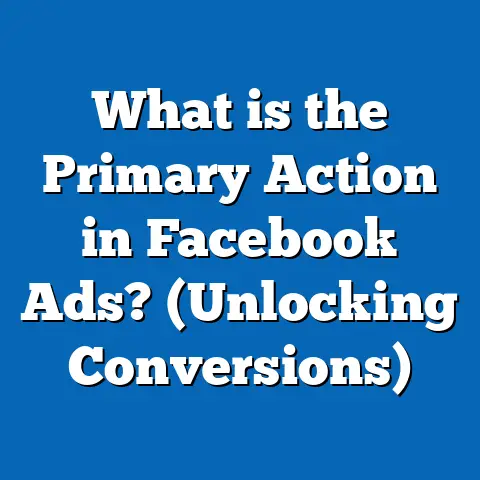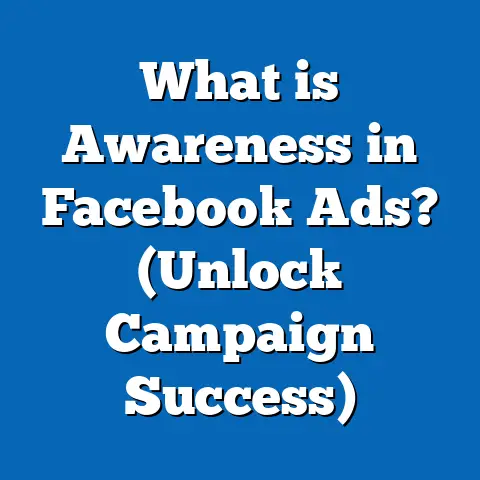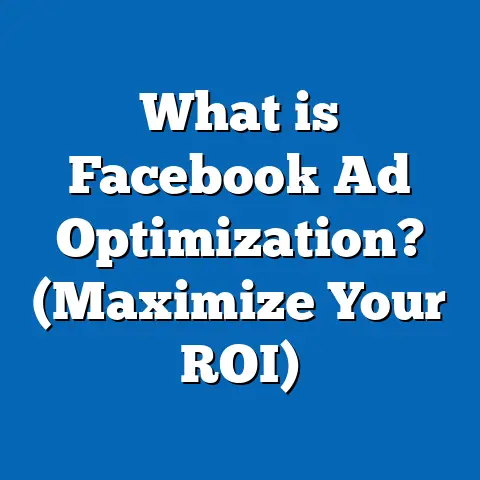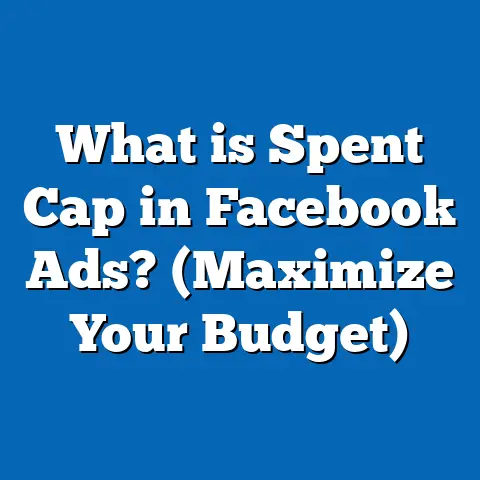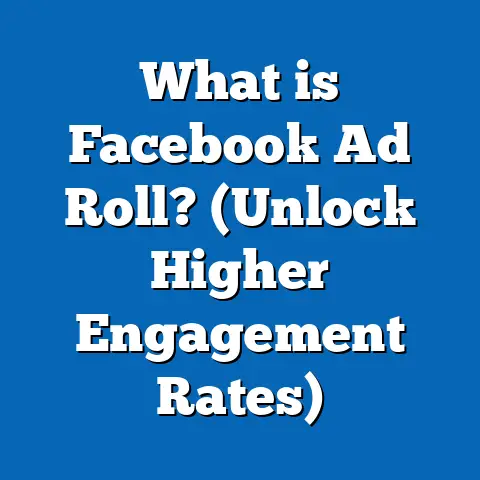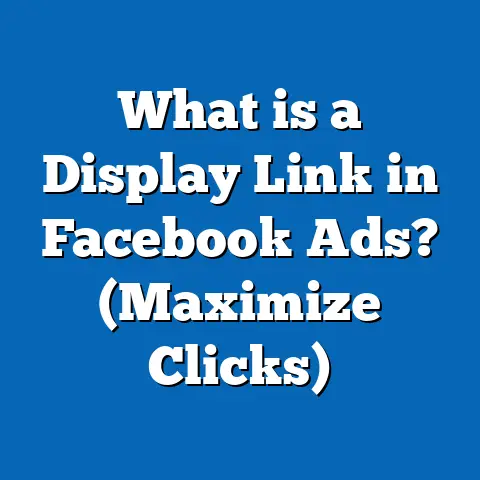What is a Good Website Conversion Rate for Facebook Ads? (Expert Insights)
Introduction: Unlocking the True Potential of Facebook Ads Through Website Conversion Rates
Imagine turning every dollar spent on Facebook ads into a measurable, profitable action on your website. This is the golden opportunity digital marketers and business owners are chasing. Facebook ads offer unparalleled targeting and reach, but the real success lies in the conversion rate — the percentage of visitors who take a desired action after clicking your ad. Understanding what constitutes a good website conversion rate for Facebook ads is crucial for optimizing campaigns, maximizing ROI, and scaling your business effectively.
Understanding Website Conversion Rate in Facebook Ads
What Is Website Conversion Rate?
Website conversion rate is the percentage of visitors who complete a specific action on your website after arriving via a Facebook ad. This action could be:
- Making a purchase
- Subscribing to a newsletter
- Filling out a lead form
- Downloading content
- Any other goal aligned with business objectives
Mathematically, it is calculated as: Conversion Rate=(Number of ConversionsNumber of Visitors from Facebook Ads)×100\text{Conversion Rate} = \left(\frac{\text{Number of Conversions}}{\text{Number of Visitors from Facebook Ads}}\right) \times 100
For example, if your Facebook ad brought 1,000 visitors to your landing page and 30 of those visitors made a purchase, your website conversion rate would be: 301000×100=3%\frac{30}{1000} \times 100 = 3\%
Why Conversion Rate Matters More Than Clicks or Impressions
While clicks and impressions measure engagement and reach, conversion rate directly reflects how well your website and offer persuade visitors to take action. A high click-through rate (CTR) with a low conversion rate means you’re attracting interest but failing to close the deal. Conversely, a strong conversion rate signals that your ad targeting, messaging, and website experience align perfectly with user intent.
Clicks tell you that people are interested enough to visit your site. Conversion rate tells you whether your site and offer meet their expectations enough to drive action.
What Is a Good Website Conversion Rate for Facebook Ads?
Industry Benchmarks and Averages
Benchmarks give a useful reference point but should not be treated as absolute goals. Different industries have vastly different average conversion rates due to audience intent, product complexity, price points, and sales cycle lengths.
Here are industry averages based on aggregated data from WordStream (2023), HubSpot (2024), and Facebook Business Reports:
| Industry | Average Conversion Rate (%) | Notes |
|---|---|---|
| E-commerce | 1.85% – 3.5% | Product price and seasonality affect rates |
| B2B Services | 2% – 5% | Longer sales cycles can lower immediate rates |
| Lead Generation | 5% – 10% | Quality of lead magnets impacts performance |
| Mobile Apps | 2% – 4% | Optimized app store landing pages boost rates |
| Education | 3% – 7% | Free trials and demos increase conversions |
Why Do These Rates Vary So Much?
- E-commerce: Often faces lower conversion rates because users browse many options before purchasing.
- B2B: Usually involves longer consideration phases, with multiple stakeholders involved in decisions.
- Lead Generation: Can have higher conversion rates when compelling offers such as free ebooks or consultations are used.
- Mobile Apps: Dependent on seamless app store integration and user experience.
- Education: Higher conversion rates often come from trial offers and interactive content.
How To Set Your Own Benchmark
Look at historical campaign data, competitor performance (where available), and industry reports relevant to your niche.
Deep Dive: Data-Backed Insights Into Website Conversion Rates
Conversion Rate vs. Cost Per Acquisition (CPA)
Conversion rate is closely tied to CPA—the cost required to acquire one customer or lead. A higher conversion rate generally means a lower CPA because more visitors convert without additional ad spend.
Example:
- If your ad costs $1,000 and brings 500 visitors with a 2% conversion rate: Conversions=500×0.02=10\text{Conversions} = 500 \times 0.02 = 10 CPA=100010=$100\text{CPA} = \frac{1000}{10} = \$100
Improving your conversion rate from 2% to 4% doubles conversions to 20, halving CPA to $50.
Lower CPA makes campaigns more sustainable and scalable.
Case Study: Ecommerce Brand Improving Conversion Rate by 50%
A mid-sized apparel brand ran Facebook ads targeting women aged 25-40. Initially, their website conversion rate was about 1.8%. After improving product page load speed, simplifying checkout, and adding social proof:
- Conversion rate increased to 2.7%.
- Monthly sales rose by 45%.
- CPA decreased by 30%.
They achieved this by:
- Compressing images for faster load times.
- Adding customer reviews and testimonials.
- Reducing checkout steps from five to three.
- Using urgency cues like limited-time offers.
This case highlights how small on-site changes can significantly improve Facebook ad conversions.
Statistical Insight: Correlation Between Landing Page Load Speed and Conversion Rates
According to Google:
- A delay of just one second in page load time can reduce conversions by up to 20%.
- Websites loading within two seconds have twice the conversion rates compared to those loading in five seconds or more.
This is critical because Facebook ads often target mobile users where connection speeds vary widely.
How to Measure and Analyze Your Conversion Rate Effectively
Essential Tools for Tracking Conversions
- Facebook Pixel The Facebook Pixel is critical for tracking user behavior after clicking an ad. It records events such as page views, add-to-cart clicks, purchases, sign-ups, etc., enabling you to measure conversions accurately.
- Google Analytics Use GA alongside Facebook Pixel for deeper insights into user behavior beyond the initial click. GA helps you understand bounce rates, time spent on site, traffic sources breakdown, and more.
- UTM Parameters Tag URLs in your Facebook ads with UTM codes to differentiate campaigns in Google Analytics. This gives granular data on which ads drive traffic and conversions.
Metrics You Should Track Alongside Conversion Rate
- Bounce Rate: Percentage of visitors who leave without any interaction.
- Average Session Duration: Longer sessions typically indicate higher engagement.
- Pages per Session: More pages viewed often correlate with higher likelihood of conversion.
- Return on Ad Spend (ROAS): Revenue generated per dollar spent on ads.
- Cost Per Click (CPC) & Click-through Rate (CTR): To evaluate ad engagement quality.
Common Issues That Lower Facebook Ads Conversion Rates
Poor Audience Targeting
Ads shown to irrelevant or broad audiences tend to attract clicks but low conversions. This results in wasted spend.
Low Landing Page Relevance
If the landing page doesn’t match the ad message or user expectations set by the ad creative, visitors bounce quickly.
Slow Website Load Times
Delays frustrate users and increase bounce rates dramatically.
Complex or Lengthy Forms
Asking for too much information upfront discourages users from completing actions like sign-ups or lead forms.
Lack of Trust Signals
Absence of reviews, guarantees, or secure payment badges reduces confidence in completing purchases or form submissions.
Advanced Concepts: Optimizing for Higher Website Conversion Rates
A/B Testing Ads and Landing Pages
Systematic testing involves creating two or more variants of an ad or landing page element (headline, image, CTA) and comparing which performs better.
Key elements to test include:
- Headline clarity
- Call-to-action button color/text
- Image vs video creatives
- Form length and layout
- Page copy length and tone
Repeat tests continuously to maintain performance gains over time.
Funnel Optimization: Identifying Drop-Off Points
Map each step from ad click to final conversion. Use tools like Google Analytics funnel visualization or Hotjar heatmaps to see where users abandon the process.
Common drop-off points:
- Landing page load time
- Checkout form completion
- Payment page errors
Addressing these specific issues improves overall conversion rates efficiently.
Personalization and Segmentation
Using Facebook’s custom audiences allows you to tailor ads based on:
- Past purchase behavior
- Website activity (e.g., viewed product pages but didn’t buy)
- Demographics (age, gender)
- Location
Personalized ads tend to perform better because they feel relevant.
Example: Showing ads for winter jackets only to users in colder climates during winter months increased conversions by 35% in one campaign.
Retargeting Strategies
Retarget people who engaged but didn’t convert with:
- Discount offers
- Free shipping incentives
- Scarcity messaging (“Only X items left”)
- Testimonials or reviews to build trust
Retargeting typically has higher conversion rates than cold audience campaigns because users are already familiar with your brand.
Comparing Facebook Ads Conversion Rates with Other Platforms
| Platform | Average Conversion Rate (%) | Comments |
|---|---|---|
| Google Ads | 3.75% | Higher intent users searching for products |
| Instagram Ads | 1.5% – 2.5% | Visual platform; younger audience |
| LinkedIn Ads | 2% – 6% | B2B focus; higher cost per click |
| Twitter Ads | ~1.5% | Engagement often favors awareness over action |
Facebook’s advantage lies in its robust targeting options combined with diverse ad formats such as video, carousel, collection ads, and dynamic product ads.
Google Ads often convert better for direct response because users have intent when searching keywords. However, Facebook excels at prospecting new audiences based on interests and behaviors.
Instagram’s slightly lower average conversion rate reflects its younger demographic who might browse more than buy. LinkedIn works well for B2B where purchase cycles are longer but ticket sizes are higher.
Practical Examples: Real-World Applications of Conversion Rate Optimization (CRO)
Example 1: SaaS Company Increasing Free Trial Signups
A SaaS company specializing in project management software initially had a Facebook ad conversion rate of around 3%. By implementing these changes:
- Targeting lookalike audiences modeled on existing customers.
- Reducing sign-up form fields from five to two.
- Using benefit-focused headlines (“Get organized in minutes”).
The company increased its trial signup conversion rate to 6%, doubling leads within three months without increasing ad spend.
Example 2: Local Restaurant Boosting Online Reservations
A local restaurant used Facebook Lead Ads integrated with their reservation system. They:
- Created compelling offers such as “Book now & get free dessert.”
- Used geo-targeting within a five-mile radius.
Result: Online reservations jumped from under 1% website conversions to nearly 8% on lead form submissions directly through Facebook ads.
Example 3: Fashion Brand Using Dynamic Product Ads (DPA)
A fashion retailer used Dynamic Product Ads that automatically show personalized products based on user browsing behavior on their website.
By retargeting cart abandoners with DPA showing exactly what they left behind plus complementary items:
- Conversion rates improved from 2% on static ads to over 4%.
- Average order value increased by 15%.
Latest Trends Impacting Facebook Ads Conversion Rates in 2024
AI-Powered Audience Targeting
Facebook uses machine learning algorithms to optimize ad delivery for conversions by dynamically adjusting bids and targeting based on real-time data.
Marketers can leverage this by using campaign objectives focused on conversions rather than clicks or impressions alone.
Video Ads Dominance
Video content captures attention better than static images. According to Wyzowl’s latest report (2024):
- Video ads have a 27% higher CTR than image ads.
- They increase conversion rates by up to 34%.
Marketers should incorporate short-form videos demonstrating product benefits or customer testimonials.
Privacy Changes & Tracking Challenges
Apple’s iOS updates limiting tracking via App Tracking Transparency (ATT) impact how accurately conversions are attributed from iOS devices.
Solutions include:
- Aggregated Event Measurement setup in Facebook Business Manager.
- Server-side tracking implementations.
Marketers need patience and smarter attribution models until privacy policies stabilize further.
Conversational Ads & Chatbots
Facebook’s integration of chatbots directly within Messenger allows advertisers to start conversations leading users through qualification questions before making an offer—this softens the sales process increasing conversions especially for high-ticket items or services requiring consultation.
Shoppable Posts & Instagram Integration
Facebook Shops and Instagram Shopping allow direct product tagging in posts/ads enabling users to purchase without leaving the app—reducing friction significantly for e-commerce brands.
Step-by-Step Guide: How To Improve Your Website Conversion Rate for Facebook Ads
Step 1: Set Clear Objectives & KPIs
Define what counts as a conversion—purchase? Lead? Signup? Then set measurable goals based on industry benchmarks tailored for your business size and vertical.
Step 2: Install Tracking Tools Correctly
Ensure Facebook Pixel is installed properly with all relevant standard/custom events configured. Set up Google Analytics goals mirroring your conversion actions.
Step 3: Audit Your Current Campaigns & Landing Pages
Identify where drop-offs occur using analytics tools. Check landing page speed using Google PageSpeed Insights or GTMetrix. Review mobile responsiveness rigorously since most traffic is mobile-driven.
Step 4: Improve Ad Relevance & Targeting
Use audience insights from Facebook Analytics to refine targeting—demographics, interests, behaviors. Test different creatives aligned with customer pain points or desires.
Step 5: Optimize Landing Pages For Conversions
Make sure landing pages:
- Have clear headlines matching ad messaging.
- Use concise persuasive copy focused on benefits.
- Include strong CTAs visible above the fold.
- Display trust signals like security badges and testimonials.
Simplify forms—only ask essential info first.
Step 6: Implement Retargeting Campaigns
Create segmented retargeting audiences such as cart abandoners or page viewers without conversion. Use personalized offers or social proof ads.
Step 7: Conduct A/B Testing Continuously
Test one variable at a time—ad creative type, headline wording, CTA button color—to scientifically improve performance over time.
Step 8: Analyze & Adapt Based on Data Weekly
Review campaign performance weekly focusing on ROAS, CPA, CTR alongside conversion rates. Pause underperforming ads; scale winners strategically.
Troubleshooting Common Problems With Low Website Conversion Rates
| Problem | Possible Cause | Solution |
|---|---|---|
| High Clicks but Low Conversions | Poor landing page relevance | Align landing page messaging with ads |
| Low Mobile Conversions | Slow mobile site or poor UX | Optimize mobile speed & design |
| High Bounce Rate | Confusing navigation or misleading ads | Simplify navigation; match ad promise |
| High Cart Abandonment | Complicated checkout process | Streamline checkout; add trust badges |
| Low Form Completion | Lengthy forms; asking sensitive info | Reduce fields; use progressive profiling |
Expert Tips From Industry Leaders on Maximizing Facebook Ads Conversion Rates
- Neil Patel: “Focus on user intent — align every step from ad copy through checkout with what your audience expects.”
- Amy Porterfield: “Test relentlessly but keep learning from qualitative feedback like customer surveys.”
- Jon Loomer: “Leverage custom audiences aggressively — retarget warm leads first before cold prospecting.”
- Mari Smith: “Invest in video content as it builds emotional connection faster.”
- Andrew Foxwell: “Don’t neglect post-click experience — fast sites win.”
Summary: Key Takeaways and Next Steps
A good website conversion rate for Facebook ads varies by industry but typically ranges from 2% to 7% depending on sector specifics and campaign goals.
Key factors influencing conversions include:
- Audience targeting precision
- Landing page quality (speed + UX)
- Offer strength & relevance
- Ad creative effectiveness
- Funnel smoothness & retargeting efforts
Measuring success requires accurate tracking via Facebook Pixel + Google Analytics combined with continuous testing and optimization cycles.
Stay updated with platform trends such as AI targeting advancements, privacy changes affecting attribution, video ad dominance, conversational marketing integration via chatbots, and shoppable post features especially for e-commerce brands.
Next Steps:
- Audit current campaigns focusing on website conversion metrics.
- Optimize landing pages for speed, clarity, mobile usability.
- Refine audience targeting using custom/lookalike audiences.
- Implement retargeting campaigns with personalized offers.
- Execute ongoing A/B tests on creatives and landing page elements.
- Analyze reports weekly adjusting budget allocation toward highest converting segments.
- Experiment with video formats & conversational ads.
- Keep abreast of privacy policy impacts and adjust attribution accordingly.
By mastering these elements methodically you can maximize ROI from Facebook ad spend while building sustainable growth through improved website conversions.
If you want me to generate supporting visuals/charts or provide templates for campaign setup/checklist documents as well, please ask!

